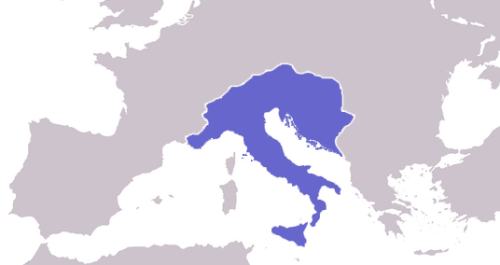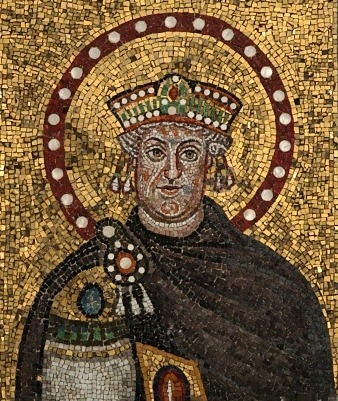peashooter85:The short lived revival of Rome under Theodoric,In previous posts I have written about
peashooter85:The short lived revival of Rome under Theodoric,In previous posts I have written about how Odoacer overthrew the last Western Roman Emperor and how Theodoric overthrew Odoacer and declared himself King of Italy. There is often a myth in the history of Western Europe that the barbarians tore down Roman civilization, ushering in the so called Dark Ages. There is debate as to how dark the Dark Ages were in Western Europe. Of course the barbarians didn’t conquer Rome by being nice, but modern historians generally find that the barbarians weren’t as barbaric or destructive as previously thought. Nothing demonstrates this more than the reign of Theodoric the Great, the Ostrogothic king who founded the Ostrogothic Kingdom of Italy after the fall of Rome. Under Theodoric, Italy saw a short live revival of Roman culture. Instead of trying to impose Gothic law on his Roman subjects, Theodoric adopted Roman law for the kingdom, using the still intact Imperial government to govern Italy in his name. Goth’s themselves were under the jurisdiction of traditional Gothic law separate from the Italians, however they were a very small minority within Italy. Trying to force foreign law on an overwhelming majority probably wouldn’t have ended well, plus it didn’t make sense to build a new governing system from the ground up when the old Imperial system was still intact. One little known fact was that under Theodoric, the Roman Senate would continue to operate, even functioning as late as 603 AD. Throughout late Roman history, much of Rome’s decline was due to corruption and incompetence. Theodoric reformed Roman government by rooting out and eliminating corruption, removing corrupt bureaucrats from their posts and punishing crimes against the state which patricians had long been able to get away with under the emperors. Theodoric also sought to repair the empire, commissioning a number of government sponsored projects to repair the crumbling infrastructure of Italy including it’s aqueducts, roads, public baths, city walls, palaces, and administrative buildings. Projects were also undertaken to repair the ancient monuments and architecture of Rome built by the emperors hundreds of years ago. In addition Theodoric would commission a number of new building projects, one of the most famous is the Basilica of Sant'Apollinare Nuovo in Ravenna, which is today recognized as one of the greatest examples of late Roman/early Medieval art and architecture.Theodoric also worked to enhance education and learning by commissioning a number of scholarly projects to translate Latin and Greek texts into Gothic and other languages. Perhaps the most important of Theodoric’s achievements was that of peace. Through a combination of diplomacy and military success Theodoric was able to bring peace to Italy, a peace which the Roman’s hadn’t experienced for over a century.The result of Theodoric’s governance was a renaissance of Roman culture. Trade routes were restored and commerce returned to Italy. Wealth was returning to Rome and government coffers began to fill as the Italian economy made a booming comeback. Whereas before Romans fled the cities to the countryside, now Romans were moving from the countryside and repopulating the cities, leading to a renewal of urban culture. Even the most iconic of Roman traditions had been renewed, the games and spectacles of the Colosseum. Rome was coming back under Theodoric. Perhaps the Western Roman Empire would continue under a new Gothic-Italic state. It wouldn’t even have been unprecedented for Theodoric or one of his heirs to adopt Imperial titles and form a new Imperial Dynasty, but of course, this never happened. So where did it all go wrong?While Theodoric’s administration brought prosperity back to Rome, the only thing that maintained stability within that administration was the charismatic rule of Theodoric himself. As Theodoric aged and his health and mental faculties deteriorated, so did did the quality of his governance. In 526 AD Theodoric died after having ruled for over three decades. He was the last ruler of a united Italy until the mid 19th century, and essentially he was the last Western Roman Emperor in all but name and title. It was at this point that another Roman tradition was revived; conflict over who the ascend to the throne. Immediately the Goths would begin to feud over who would be the next king. Ironically it would not be the Goths who destroyed Rome, but the Romans themselves, more specifically the Eastern Romans, AKA the Byzantine Empire. In 535 the Byzantines invaded Italy as part of Eastern Roman Emperor Justinian’s campaigns to recover the lost provinces in the west. He came close, conquering much of Italy, North Africa, and Spain.The war between the Byzantines and Goths would last from 535 to 554, and would lead to the destruction of much of what Theodoric had built. Italian cities changed hands often, enduring looting and vandalism in the process. Once again people fled the cities to the countryside in order to escape the war, depopulating the cities. The city of Rome itself had a population of around 100,000 during the reign of Theodoric, but less than 30,000 by the end of the war. Italian infrastructure was once more destroyed, resulting in a breakdown of trade and commerce. Much of the Italian population died of resulting famines and disease. While the Byzantines were successful in conquering Italy and much of former western provinces, Justinian’s military campaigns drained the Imperial coffers and left the Eastern Roman Empire flat out broke. This combined with a series of plagues weakened the empire to the point that they were vulnerable to invaders such as the Slavs, Lombards, Persians, Turks, and Arabs. In Italy the new Byzantine government lacked the money and resources to repair the damage done from the Gothic War or maintain the province’s infrastructure. Thus Italy once again fell into a state of disrepair and economic stagnation. The Dark Ages had truly become dark for the Romans. -- source link
Tumblr Blog : peashooter85.tumblr.com



